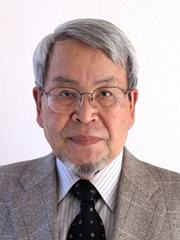2009 Recipients of C&C Prize
Group A

Dr. Fumitada Itakura
Professor, Meijo University
Professor Emeritus, Nagoya University
Citation
For pioneering research and the development of highly efficient voice-coding technology with analysis-synthesis methods for speech
Achievement
Dr. Fumitada Itakura started his pioneering research on efficient voice coding during his doctor’s course at Nagoya University. Boosting the level of research at the Electrical Communication Laboratory of NTT Public Corporation and AT&T Bell Laboratories, he developed a number of fundamental new methods one after another. These methods were based on frequency spectrum-parameter extraction from speech signals using statistical approaches. His approaches involved approximating vocal-tract characteristics using an all-pole digital-filter model, transmitting its filtering coefficients, and reproducing the original voice with a speech synthesizer. These methods enabled the speech signal data rate to be reduced to 1/10 to 1/20 of that for the pulse-code modulation (PCM) method, which transmits speech data using the direct digitization of speech waveforms.
The first analysis-synthesis approach developed by Dr. Itakura in 1966 was based on maximum likelihood spectrum estimation. It analyzed voices to obtain filtering coefficients effectively and suitably for synthesis using the estimation method. Dr. Itakura was the first to propose an algorithm for the approach, established the approach mathematically, and demonstrated clear and natural voice reproduction using the synthesis. In addition, he improved its filter stability by introducing partial correlation coefficients using forward and backward prediction errors and developed the partial auto correlation (PARCOR) method in 1969.
The PARCOR method was put to practical use as an audio response system in 1971 and was used for various telephone data services. His research totally modernized the conventional speech analysis-synthesis methods and paved the way for new speech research areas.
In 1975, fostering the advancement of an algorithm for PARCOR, he developed the line spectrum pair (LSP) method by introducing the line spectrum representation of linear predictor coefficients of speech signals. The LSP method further improved the quantization properties in speech synthesis and reduced the effects of coding errors, which made it suitable for use in digitalization. It is also very well suited for use in coding LSIs, which proved to be beneficial for making mobile terminals smaller and reducing power consumption.
A voice coding system based on the LSP method was adopted as an international standard and became ITU-T specifications such as both G.723 and G.729 in 1995. Specification G.729 has been widely used as low-bit-rate compression coding for VolP worldwide. For instance, previously, Japan created a second-generation mobile phone system called Personal Digital Cellular (PDC), Europe made a second-generation one dubbed Global System for Mobile Communications (GSM), and third-generation mobile phone systems such as W-CDMA were also made. In each case, these systems were developed based on fundamental technologies such as PARCOR and LSP pioneered by Dr. Itakura, reproducing clear vocal sounds with only 1/10 to 1/20 of the data rate compared with that of PCM technology.
Consequently, the NEC C&C Foundation highly praises Dr. Itakura for his pioneering research and development of fundamental technologies indispensable to current mobile phone systems and VolP. His achievements laid the foundation for achieving international standards for low-bit-rate compression coding and the widespread use of mobile phone systems.
